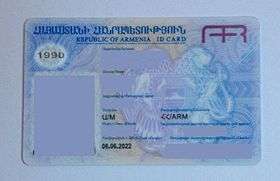Armenian passport
Armenian Passports are issued to Armenian citizens to travel outside Armenia. They are also used as proof of identity within the country, along with Armenian ID cards.
| Armenian passport | |
|---|---|
 The front cover of a contemporary Armenian Biometric Passport. | |
| Type | Passport |
| Issued by | |
| Purpose | Identification & International Travel |
| Eligibility | Armenian citizenship |
| Expiration | 10 years |
Physical appearance
An ordinary Armenian passport is dark blue, with the Armenian coat of arms emblazoned in gold in the center of the front cover. The words (Armenian: Հայաստանի Հանրապետություն) "Republic of Armenia" and (Armenian: Անձնագիր) "Passport" on Armenian and English languages also appear on the front cover. The passport is valid for 10 years from the time of issue, with the further possibility of extending validity for an additional 5 years. The possibility of extending the passport by 5 years was eliminated in August 2017.[1] It contains 32 pages for special notes and visas, and information about its holder in both the Armenian and English languages. Since 1 June 2012, two new ID-documents are introduced, which will replace the ordinary passports of Armenian citizens. One of the documents – the ID card — will be used locally within the country, and the second document – the biometric passport — will be used for traveling abroad. An electronic chip on the passport will contain digital images of fingerprints and photo of passport holder. Both biometric passports and eID cards are produced by Polish Security Printing Works (Polska Wytwornia Papierow Wartosciowych).[2] Old style (non-biometric) passports were re-introduced in 2016 on a temporary basis (until January 1, 2019), and currently Armenian citizens can acquire both biometric and regular passports.[3]

Armenia abolished the visa requirement for citizens of the Schengen states From 1 January 2013 Armenia will drop the requirement of an entry visa for the 27 EU countries and 4 additional countries, fulfilling the requirements of the Schengen Agreement (Iceland, Liechtenstein, Norway and Switzerland). By unilateral abolition of the visa regime, Armenia seeks to accelerate negotiations with the EU on visa facilitation. According to the planned agreement with the EU, the procedure for obtaining Schengen visas for citizens of Armenia would be facilitated. The simplified procedure is provided for members of official delegations, researchers, students, journalists, those in sports and the arts, and for close relatives of citizens legally residing in the EU. It is also intended to reduce visa costs by 35 euros to free for these categories, as well as for children and pensioners. For more info see at E-visa system.
Identity information page
Armenian Passport includes the following data:
- Photo of Passport Holder
- Type (P)
- Country Code (Arm)
- Passport No.
- Surname (1)
- Given Names (2)
- Nationality (3)
- Date of Birth (4)
- Sex (5)
- Country of Birth (6)
- Date of Issue (7)
- Date of Expiry (8)
- Issuing Authority code (9)
Limitations on passport use
As a result of the Nagorno-Karabakh War between Artsakh, Armenia and Azerbaijan, Azerbaijan refuses entry to holders of Armenian passports, as well as passport-holders of any other country if they are of Armenian descent. It also strictly refuses entry to foreigners in general whose passport shows evidence of entry into the self-proclaimed Artsakh, immediately declaring them permanent personae non gratae.
Visa requirements

- In 2019, Armenian citizens had visa-free or visa on arrival access to 62 countries and territories, ranking the Armenian passport 78th in the world according to the Henley & Partners Passport Index.[4]
- As of 2018, holders of an Armenian passport may enter all Commonwealth of Independent States and Eurasian Union member states without a visa.
- The Head of the EU Delegation to Armenia, Ambassador Piotr Switalski stated that, the action plan for beginning visa liberalization between Armenia and the EU will be on the agenda of the next Eastern Partnership summit in 2017 and dialogue for visa-free travel of Armenian citizens to the EU's Schengen Area will begin in early 2018.[5] The Ambassador also stated that Armenian citizens would be granted visa-free travel to the EU by 2020.[6]
See also
References
- "Validity of old-styled Armenian passports will not be extended anymore". arka.am. Retrieved 2017-09-02.
- http://www.pwpw.pl/index.php?pId=597
- "Կենսաչափական անձնագիրն այլեւս պարտադիր չէ, քաղաքացիներին կտրամադրվի հին նմուշի անձնագիր". Armtimes.com (in Armenian). Retrieved 2017-09-02.
- "Henley & Partners Passport Index". Archived from the original on 2019-07-05. Retrieved 2019-04-03.
- . 2017-03-15 http://asbarez.com/152953/visa-liberalization-with-armenia-on-2017-eastern-partnership-summit-agenda/. Missing or empty
|title=(help) - . 2018-03-09 http://www.panarmenian.net/eng/news/249278/. Missing or empty
|title=(help)